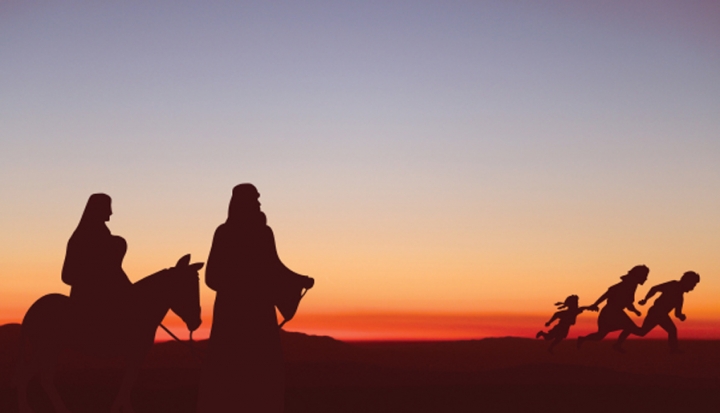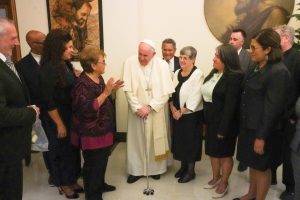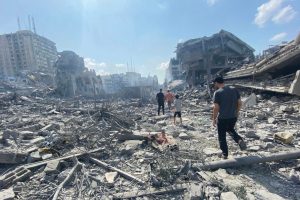It’s nearly lunchtime in the west Michigan city of Kalamazoo. “Auntie” Saheeda Perveen Nadeem, 64, stands over the stove in the kitchen at First Congregational United Church of Christ (FCUCC) preparing a nutritious lunch for 20 children living in poverty.
During the more than a year and a half in which she has been sequestered inside the church as a migrant receiving sanctuary protection, Nadeem often cooks for large groups, provides child care, and connects with church leadership. As a Muslim, she practices her faith by serving others through food, even as she fasts during Ramadan. As a migrant, she is a surrogate mother to more than a dozen others who have arrived in the United States fleeing violence.
Nadeem fits the trope of the model immigrant: She has always paid her taxes and never committed a crime (not even a parking violation). She is deeply committed to her local community, and they in turn are committed to her.
It came as no surprise when church leaders began to accompany her to appointments with Immigration and Customs Enforcement (ICE) officials. “ICE in Michigan had been fairly balanced,” notes the Rev. Nathan Dannison, senior pastor of FCUCC. “When a new director took over, however, they rolled out a policy with zero stays of removal,” the temporary postponement that allows migrants like Nadeem to remain in the United States despite lack of documentation.
As valued members of their communities are targeted by ICE for arrest, detention, and deportation, Christians confront a profound conflict between the inhumane policies of the Trump administration and the call to love the immigrant. Those targeted for arrest and removal are not, after all, hardened criminals with violent records. They are elders, those living with chronic illness, visionary dreamers, families facing domestic violence, parents who care for disabled children, and even clergy.
Forced from her birthplace in Pakistan by poverty, Nadeem worked briefly as a maid in Kuwait, sending earnings back to her family. Shortly after having her own children she made the difficult decision to relocate to the United States to provide them with a better life. Unbeknownst to her (as the matter was handled by her then husband), she overstayed her visa. With very few exceptions, the path to legal citizenship closes permanently if a migrant is ever found to be residing in the United States illegally. Such was the case for Nadeem, who worked under the table for less than minimum wage while still paying taxes.
Nadeem was taken into sanctuary after an ICE official said she would be denied a stay and deported. Not only does she face threats by her ex-husband and his tribal community back in Pakistan should she return, Dannison reports that health challenges place her at risk, possibly death, should she undergo a lengthy detention.
When Dannison first heard the news of Nadeem’s possible deportation from the “mocking voice of an ICE official,” he says, “It was, to me, as if someone had burned a flag. I thought certain things were inalienable, such as the God-given rights outlined in the Constitution, which apply to all human beings living in the United States, regardless of citizenship. That’s no longer the case.”
The facilities that currently house those awaiting deportation are privately owned, for-profit companies, so “we are battling a wealthy beast here,” he says.
As Christians await the holy celebration of the Christ child’s birth, the tumult of ICE raids, palpable fear within immigrant communities, and lonely isolation of those living in sanctuary threaten to trouble the insular joy of the season.
The Holy Family’s flight to Egypt provokes the question: Do American Christians truly see Jesus in the least of these? In communities across the country, people of faith are awakening to the urgency of this moment and standing alongside the immigrant fashioned in the image of Christ.
Sanctuary
Like Nadeem, Mohamed Soumah, another migrant living in sanctuary at a Quaker church and home in Ann Arbor, Michigan, also finds his situation complicated by illness. Sick with kidney disease, Soumah requires dialysis three times weekly. As an undocumented immigrant, he is ineligible for organ donation.
“It’s possible he could die in sanctuary,” concedes the Rev. Deborah Dean-Ware, whose UCC congregation helps support Soumah. According to her Guinea will not accept Soumah back, and his return would be a death sentence due to inadequate health care. (His mother died of kidney disease shortly after returning to Guinea and receiving dialysis there.)
Dean-Ware coordinates the interfaith group of clergy who transport Soumah to every dialysis appointment, waiting as the four-hour procedure ticks toward completion. Each clergy person who transports him wears a tab-collared shirt or stole as a symbol of sanctuary. Dozens of other volunteers offer services to Soumah, such as providing therapy, drawing up his tax forms, and coordinating the monitors who mind the door of the Quaker buildings that house him.
“It’s very boring, house arrest,” says Dean-Ware. “We got him an exercise bike. He’ll walk laps around the sanctuary. The stress is real and difficult to manage. He’s lost a lot of weight.”
ICE raids
Under the presidency of Donald Trump, immigrant neighbors live in fear as loved ones disappear in communities across the country. In the April 2018 ICE raid of Buncombe and Henderson counties in North Carolina, about 15 immigrants were arrested and detained as part of a statewide raid that netted more than 40 arrests.
Community organizer Bruno Hinojosa remembers the call to the immigrant hotline at 6:30 in the morning. A suspicious car was seen picking up two known community members. Could Hinojosa’s organization, Compañeros Inmigrantes de las Montañas en Acción (CIMA), verify whether ICE was in town carrying out raids?
Prior to 2018 most raids took place in restaurants or manufacturing plants employing undocumented immigrants. This time, Hinojosa says, “ICE was everywhere—at your home, out in the community.” Because CIMA had spent years cultivating best practices and guidelines for interacting with ICE, it trained local activists in the verification process. Those individuals were deployed to Hendersonville shortly after the sun rose in search of ICE vehicles.Fresh calls continued to roll in, and once CIMA was able to verify the presence of ICE in the area, the organization blasted a warning to the immigrant community through social media along with know-your-rights information.
As families began to hunker down in their homes, CIMA reached out to the sanctuary network of churches, requesting emergency food assistance and other supplies be dropped off at BeLoved Asheville, an intentional community, and Land of the Sky United Church of Christ.
BeLoved Asheville delivered those supplies to neighborhoods specified by CIMA and Nuestro Centro, the local Latino community center. Meanwhile, families whose loved one was arrested were welcomed at Nuestro Centro, where a healing corner, resources, and compassionate hospitality awaited them.
Two days later, as raids continued, CIMA organized a press conference and met personally with members of the city council and the county commissioners, who were taken aback to see ICE launch such comprehensive raids in their community.
“We were criminalized and persecuted, dehumanized by seeing ICE officers running their cars in our community streets, up and down, with people not able to go out to pick up their children or groceries,” says Dulce Mirian Porras Rosas, director of Nuestro Centro. “For four nights in a row we were terrorized, day and night. We didn’t know what would happen overnight,” she adds, “if you would see your family, neighbors, or children again.”
As the raids were winding down, ICE officials held a picnic to celebrate their success. Immigrants and their allies showed up with a marching band to chant and sing, disrupting the festivities. “It was important to feel that community strength and courage,” Hinojosa says of the action that eventually shut down the ICE picnic.
Since the raids, CIMA has partnered with a local legal aid organization to help families who may be affected by raids in the future draw up legal documents that specify their contingency plans. Over 60 families have participated, answering questions such as: If you are deported, who will care for your child?
The stress infects even immigrants who are legal citizens. Individuals, even those who hold professional positions in the community, drive around with their passport for fear of being mistakenly detained. In hard times, Hinojosa notes, “faith fuels people.” Some members of his community exercise their faith through indigenous traditions such as smudging or herbal tinctures, others through church.
“It helps for folks to know that they are not alone in a moment of crisis. They have a community and tools,” he says.
Paradoxically, the scorched earth tactics of the Trump administration have only served to empower community organizing, know-your-rights education, and the resilience of immigrants in Hinojosa’s neck of the woods. Never before have they claimed with such conviction that they belong here.
“We will end ICE,” Porras Rosas says.
“This system is making millions of dollars out of our bodies. We will not allow [ICE] to continue taking our children and snatching people from our communities.”
Detention
In Miramar, Florida an ICE facility processes undocumented immigrants from the southern part of the state. Migrants travel for hours to find out whether they will be deported, lining up outside the facility as early as 4 a.m.
They wait for hours in the elements, sometimes from sunrise to sunset, often enduring extreme heat without access to shelter or restrooms. Many will return the following day if their case is not decided the first day. Sometimes they are processed, released, and given a date to return or an ankle bracelet; others are removed directly to a detention facility for deportation.
A steadfast group of local volunteers sets up tables across the street each week to offer free water, food, and coffee.
Destiny Aman, a first-time volunteer who happened to be vacationing nearby, says, “They describe how things used to be when longtime residents checked in once a year and how things escalated under Trump. . . . Some old enough to push walkers, some who’ve lived in the United States for more than 30 years have disappeared inside the building, with families calling in panic, asking what to do. The Miramar Circle of Protection formed in response with a threefold mission: Comfort, Witness, Resist.”
Through a local organization, Aman and her spouse, Julie VanEerden, visited a detention center the previous day to spend time with detainees, whom they described as “warm and open, grateful for a visit and a chance to connect.”
The presence of God in that place struck a deep chord within the couple. They saw God in the peaceful faces of babies hugging their papis, unconcerned about security protocol; in the volunteers working hard to ensure detainees are not deported, possibly to their deaths; in the detainees themselves who have entrusted their lives into divine hands. They saw Jesus in the family who shared a long prayer even as the guards flickered the lights to signal the end of the visit.
Christ incarnate
The Christmas story bears a shadow side, and the material joy of Christmas that culminates in opening the last gift under the tree is not in keeping with the historical practice of Christmas. The fullness of the Christmas story is in both its beauty and brokenness.
Long ago the Christian tradition set aside 12 days to celebrate Christmas—inviting the faithful to linger over the Christ child, to hear the testimony of the ragtag shepherds confronted by an angelic chorus, to journey with the magi, and to face the brutality of King Herod and the harrowing flight of the Holy Family to Egypt.
The Feast of the Holy Innocents, marked during the first half of the 12 days of Christmas, recalls Herod’s massacre of young children in Bethlehem, a fate Jesus escaped when his family took flight as political refugees on the run for their lives.
The Holy Family’s escape to Egypt parallels the present plight of immigrant families fleeing the violence of the Northern Triangle of Guatemala, Honduras, and El Salvador. As in the exodus, when the Israelites were led by Moses out of slavery in Egypt, Mary and Joseph fled Bethlehem to seek life for their child and to escape Herod’s reign of terror.
Like them, many immigrants flee as refugees from their own homelands. As farmable land grows scarce, multinational corporations exploit cheap labor, gang violence partners with government corruption, and the lives of ordinary families collapse into danger and despair, they turn their eyes north. They risk everything to carve out a livelihood that will support their families and allow their children to grow in peace.
The incarnation of Christ claims that God’s Spirit resides in human flesh—in tender feet, blistered by flight; in the parched throat aching with thirst; in the stench of sweat-slickened fear. The Bible makes plain God’s call to welcome the stranger, to care for the foreigner, to offer hospitality to the other.
“Our faith is not just about affirming immigrants,” says Dean-Ware. “It was founded by immigrants, starting with Abraham.”
Indeed, laws sewn into the very fabric of Israel’s society reflect the value of the stranger. In the Hebrew scriptures, religious law required that landowners harvest their crops while leaving an outer ring along the border of their property to be harvested by the resident alien (Lev. 23:22).
Abraham, the father of three faiths, welcomes strangers as if they were long-awaited guests only to discover that they are angels bringing the good news that God will bless Sarah with a child. In the gospels, Jesus reappears as a stranger on the road to Emmaus, and the disciples recognize the risen Christ only after offering him hospitality and breaking bread together.
Christians are called to care for strangers as if they were Christ incarnate, to harbor refugees as if they were the Christ child on the run.
The Catholic Church in the United States, in particular, is an “immigrant church,” claims Tony Cube, manager of Justice for Immigrants, an advocacy campaign for immigration reform legislation. “Going back to Irish Catholics, Italians and southern Europeans, and—in the last half of the 20th century—Southeast Asian and Filipino refugees and immigrants. Our faith says: Seek justice for the oppressed. Clothe the naked. Period. End of sentence. Nowhere does it tell us to ask for papers first.”
Indeed, Pope Francis chose the tiny Italian island of Lampedusa for his first trip outside of Rome in 2013. He acknowledged the plight of migrants and refugees by casting a wreath into the sea that has swallowed so many migrants and their shared dream of a better home. “Migrants are symbols of all those rejected by . . . society,” the pope preached earlier this year as he commemorated that visit.
On July 12 Nadeem spoke to a crowd in Kalamazoo gathered for a local Lights for Liberty event. A window of the historical church was wrenched open, and her words streamed through the open air. “I have lived here for 16 months. If I can be strong and hopeful, then you can be strong and hopeful,” she said. A cheer rose up from the crowd.
Christmas proclaims the good news that God is with humankind and made known in the stranger. Through the incarnate Christ, God is made manifest—a God who identifies with the poor, a God known in the vulnerability of an infant, a God who will suffer in solidarity with the crucified peoples of the world. When Christians accompany the poor, the immigrant, and the stranger, they discover God with fresh eyes.
This article also appears in the December 2019 issue of U.S. Catholic (Vol. 84, No. 12, pages 24–28). Click here to subscribe to the magazine.














Add comment